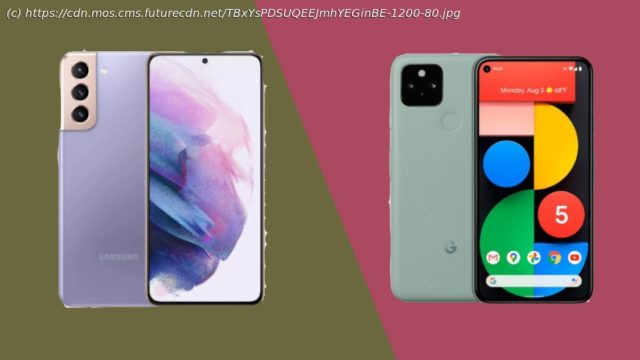Samsung and Google present contrasting cases for a more accessible flagship phone
The Samsung Galaxy S21 and the Google Pixel 5 represent a subtle shift in priorities from these two old rivals and collaborators. Formerly to be found competing at the very pinnacle of the smartphone market, these two prestigious phone franchises now occupy a slightly lower tier. One where several key compromises have been made in order to meet a more modest price point. So how do these two not-quite-flagships stack up against one another? We scored both a decent 8 out of 10 in their respective reviews, so buckle up for a close fight. The Samsung Galaxy S21 arrived in shops on January 29, 2021, for a starting price of $799 / £769 / AU$1,249 for the 128GB model. The 256GB model arrived at $849.99 / £819 / AU$1,349. These prices are holding firm on the official Samsung website, but you’ll almost certainly be able to find a good deal on the S21 if you shop around. At the time of writing, you could get a 128GB Galaxy S21 from Amazon for $699 / £664. Google made its Pixel 5 available on October 15,2020. The one available 128GB model arrived at $699 / £599 / AU$999 from the official Google Store, and these prices have largely held firm ever since. Again, you can get a deal on the phone from third-party sellers, although these don’t tend to be as impressive as those of the Samsung, despite the Pixel 5’s greater age. At the time of writing, the Pixel 5 costs $699 / £574 on Amazon. Both of these phones have stepped away from the glass and metal flagship playbook, but in very different ways. Google has dropped glass as a material altogether for the Pixel 5 – aside from its Gorilla Glass 6 display, of course. Housing this is a unibody aluminum chassis, with a curious matte bio-resin finish layered on top. Yes, Google has essentially covered its premium metal material with plastic. This lends the Pixel a curiously utilitarian look and feel, but it also makes it stand out from a samey flagship crowd. The resin also covers up gaps in the body that enable wireless charging. The Pixel 5 is a relatively small phone at 144.7 x 70.4 x 8mm and 151g. It’s smaller in almost every way than the Galaxy S21, which itself is only 151.7 x 71.2 x 7.9mm and 169g. Samsung has also adopted plastic for its phone’s body – or ‘Glasstic’ to use the company’s own cringey word – but this time it feels like much more of an overt compromise. Both the Galaxy S21+ and the Galaxy S21 Ultra use glass within a similar design blueprint. Still, the edge of the Galaxy S21 is metal, and it too looks quite distinctive in its own right. In particular, the phone’s swooping ‘Contour Cut’ camera module design is unique, and at least partially solves the conundrum of integrating a huge bump into the back of your phone. Samsung’s color options are much more interesting than Google’s, too. A choice of Phantom Gray, Phantom White, Phantom Pink, and Phantom Violet far outstrips the Pixel 5’s somewhat blasé offering of Just Black and Sorta Sage. Both phones have flat displays and hole-punch selfie cameras, but the Galaxy S21 places it centrally, while the Pixel 5 shifts it over to the left. We’re indifferent about the latter choice, but we wholeheartedly support the return to a more straightforward display. Another difference worth noting is the positioning of the fingerprint sensors. Samsung has opted for a more modern in-display solution, with a 70% bigger active area than before. Google, on the other hand, goes with an old-fashioned rear-mounted sensor. Neither is best in class, but we’d give Samsung the nod on this one. As we’ve just established, these are two of the smaller phones on the flagship scene, especially if you only consider Android devices.
Домой
United States
USA — software Samsung Galaxy S21 vs Google Pixel 5: pay less for your flagship...






